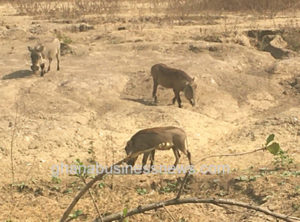Illegal chainsaw operators threaten Western Wildlife Corridor

Illegal chainsaw operators engaged in felling of trees and extraction of natural resources are threatening the landscape and forest reserves of the Western Wildlife Corridor and the Northern Savannah Forest Zone.
Apart from overgrazing, erratic rainfall and wildfires, which were causing destruction to environment, people who were engaged in the chainsaw operation businesses were illegally logging timber including economic trees, destroying the ecosystem for wild animals and efforts being made to protect the reserves.
“We have illegal chainsaw operators who cut trees without permits and are drawing our efforts backwards because if you want to cut any tree you need a permit, you cannot just enter the forest and cut the tree.”
Mr Emmanuel Owusu, Kassena-Nankana Municipal, Kassena-Nankana West, Builsa North Municipal and Builsa South District Manager, Forestry Commission, made these known to the Ghana News Agency in an interview on the sidelines of an environmental event held at Nakong.
The event organised by the Organisation for Indigenous Initiatives and Sustainability (ORGIIS-Ghana) with support from the Noe, a French based organisation was to inaugurate Community Resources Management Areas (CREMA) to sustainably manage and protect the natural reserves and resources particularly in the Western Wildlife Corridor from depletion as part of the implementation of a project dubbed, “ECONOBIO”.
Mr Owusu noted that government through various interventions including the Green Ghana Initiative had restored hectares of degraded lands through tree planting.
He said apart from the 59,000 seedlings, exceeding the 40,000 seedlings target set for the four political districts in 2021 as part of the Green Ghana project, the Commission was determined to plant about 200,000 seedlings in 2022, adding “the few areas that have been degraded, we want to bring them back.”
Mr Owusu explained that the Western Wildlife Corridor had national and global significance and underscored the need for stakeholders including the traditional authorities to support the CREMA and other efforts aimed at managing and protecting the vegetation cover.
The Western Wildlife Corridor which provides protection to the Sissili River, is part of the Mole Landscape linking the Mole National Park and the Nazinga Game Ranch and serves as travelling path for wild animals from neighbouring countries such as Burkina Faso into Ghana and vice versa.
Over the years, due to illegal mining and logging, agricultural activities, poaching, high pastoralism among others, the corridor was being degraded, destruction to economic trees such as shea and baobab, putting the livelihood of the rural communities at risk.
As result, Mr Clifford Adagnera Amoah, Programmes Manager, ORGIIS-Ghana, noted the ECONOBIO project being implemented in 10 communities along the Corridor would empower beneficiaries to sustainably manage the resources and forest reserves.
The communities are Kayoro (Wuru and Baliu), Katiu and Nakong in the Kassena-Nankana West District of the Upper East Region and Kunchogo, Kwapun, Wuru, Pudo, Banu and Basissan in the Sissala East District of the Upper West Region.
“The development of economic activities such as shea butter, honey and beeswax and baobab value chains backed by improvement in ecosystem services such conservation, sustainable management of forests and enhancement of forest carbon stock through tree planting and the preservation of water resources of the Sissili River will contribute to the creation of decent jobs, reduction in poverty and inequalities and promote gender equality and ultimately improvement in biodiversity,” he said.
Mr Julius Awaregya, Executive Director, ORGIIS-Ghana, said through the CREMA, the trees would be regenerated and contribute to mitigating climate change impact and ensuring food and nutritional security.
Source: GNA
